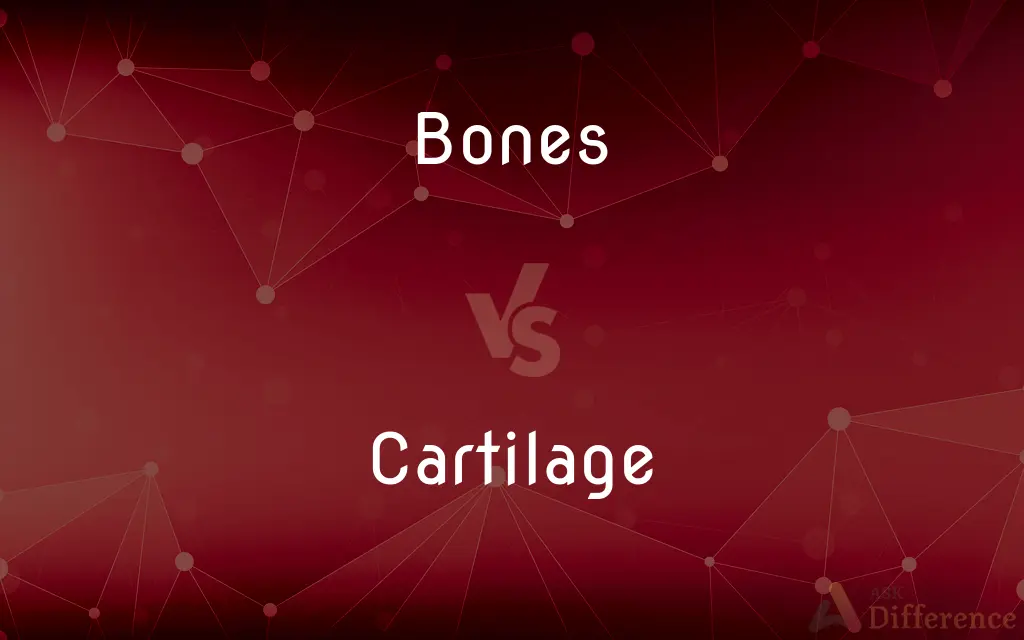Bones vs. Cartilage — What's the Difference?
By Tayyaba Rehman — Published on January 7, 2024
Bones are hard, dense connective tissues forming the skeleton, while cartilage is a flexible, rubbery tissue found in joints, ear, nose, and thorax.

Difference Between Bones and Cartilage
Table of Contents
ADVERTISEMENT
Key Differences
Bones and cartilage are both vital components of the vertebrate skeletal system but differ significantly in their composition and function. Bones are hard and rigid, composed primarily of calcium and phosphorus, providing structure, protection, and leverage for movement. Cartilage, on the other hand, is more flexible and less dense, composed of a gel-like matrix that cushions joints and enables smooth movement. While bones are associated with the production of blood cells within their marrow, cartilage does not play a role in hematopoiesis. Bones undergo continuous remodeling throughout life, repairing and reshaping in response to stress, whereas cartilage has limited regenerative capabilities.
Both bones and cartilage are connective tissues, yet they exhibit distinct physiological characteristics and serve different roles in the body. Bones contain blood vessels and nerves, allowing them to sense pain and repair themselves, while cartilage is avascular, meaning it does not contain blood vessels, which limits its ability to heal after injury. Bones provide the main structural framework for the body, supporting tissues and providing attachment points for muscles, while cartilage is found in areas requiring more flexibility, such as the nose, ear, and joints.
In terms of development, bones and cartilage have different growth patterns. Bones grow through a process called ossification, where cartilage is progressively replaced by bone tissue, especially during the early stages of development. Cartilage, however, grows by expanding from within, a process known as interstitial growth. Bones are subject to diseases such as osteoporosis, where they become brittle, whereas cartilage can be affected by conditions like osteoarthritis, resulting in degeneration and pain.
Bones and cartilage differ in their cellular structure as well. Bones are composed of osteocytes, housed in a rigid matrix that is constantly being broken down and rebuilt. Cartilage is composed of chondrocytes, which produce a large amount of extracellular matrix composed of collagen fibers, allowing for its resilience and flexibility. The maintenance of bones is influenced by dietary calcium and vitamin D, whereas cartilage health depends on a steady supply of joint fluid to provide nutrients since it lacks a direct blood supply.
Lastly, the healing process for bones and cartilage contrasts sharply. Bones can recover from fractures through the formation of a callus and eventual remodeling of bone tissue. Cartilage, due to its avascularity, has a limited capacity for repair and often requires surgical intervention to restore function when damaged.
ADVERTISEMENT
Comparison Chart
Tissue Type
Hard, rigid connective tissue
Flexible, rubbery connective tissue
Main Functions
Support, movement, protection, blood cell production
Cushioning joints, structural support for soft tissues
Composition
Calcium, phosphorus, collagen
Collagen, proteoglycans
Healing Ability
High, due to blood supply
Low, due to lack of blood supply
Growth Method
Ossification
Interstitial growth
Compare with Definitions
Bones
Objects resembling skeletal bones in shape or appearance.
The dog gnawed happily on a large bone.
Cartilage
A firm, elastic type of connective tissue.
The surgeon repaired the torn cartilage in the patient's knee.
Bones
Dice used in various games.
They shook the bones and rolled them across the table.
Cartilage
Structural tissue found in specific body parts.
His ear was flexible due to the cartilage within it.
Bones
The hard, dense connective tissue that forms the skeleton.
The human body has 206 bones.
Cartilage
A precursor to bone in fetal development.
Cartilage in the fetus will eventually be replaced by bone.
Bones
The essence or core of something.
The bones of the argument were strong, despite some unconvincing details.
Cartilage
Tissue that reduces friction in joint movement.
The cartilage in her joints was wearing down, causing pain.
Bones
The remains of a once-living organism.
Archaeologists uncovered the bones of a dinosaur.
Cartilage
A material for surgical reconstruction.
They used cartilage to rebuild the patient's nasal septum.
Bones
The dense, semirigid, porous, calcified connective tissue forming the major portion of the skeleton of most vertebrates. It consists of a dense organic matrix and an inorganic, mineral component.
Cartilage
A tough, elastic, fibrous connective tissue that is a major constituent of the embryonic and young vertebrate skeleton and in most species is converted largely to bone with maturation. It is found in various parts of the human body, such as the joints, outer ear, and larynx.
Bones
Any of numerous anatomically distinct structures making up the skeleton of a vertebrate animal. There are more than 200 different bones in the human body.
Cartilage
A usually translucent and somewhat elastic, dense, nonvascular connective tissue found in various forms in the larynx and respiratory tract, in structures such as the external ear, and in the articulating surfaces of joints. It composes most of the skeleton of vertebrate embryos, being replaced by bone during ossification in the higher vertebrates.
Bones
A piece of bone.
Cartilage
A particular structure made of cartilage.
Bones
The skeleton.
Cartilage
A translucent, elastic tissue; gristle.
Bones
The body
These old bones don't do much dancing anymore.
Cartilage
Tough elastic tissue; mostly converted to bone in adults
Bones
Mortal remains
His bones are buried up on the hill.
Bones
An animal structure or material, such as ivory, resembling bone.
Bones
A piece of whalebone or similar material used as a corset stay.
Bones
Bones(Informal) Dice.
Bones
Bones The fundamental plan or design, as of the plot of a book.
Bones
Bones Flat clappers made of bone or wood originally used by the end man in a minstrel show.
Bones
Bones (used with a sing. verb) The end man in a minstrel show.
Bones
Vulgar Slang The penis.
Bones
To remove the bones from
Bone a fish.
Bones
To stiffen (a piece of clothing) with stays, as of whalebone.
Bones
Vulgar Slang To have sexual intercourse with. Used especially of a man.
Bones
Vulgar Slang To have sexual intercourse.
Bones
Plural of bone
Bones
A percussive folk musical instrument played as a pair in one hand, often made from bovine ribs.
Bones
(informal) The act of two fists meeting together in the manner equivalent to a high-five.
Bones
(plural only) The framework or foundation of something.
Bones
A percussion instrument consisting of a pair of hollow pieces of wood or bone (usually held between the thumb and fingers) that are made to click together (as by Spanish dancers) in rhythm with the dance
Common Curiosities
What is bone made of?
Bone is primarily composed of a mineral matrix of calcium and phosphorus, as well as collagen.
Do bones contain blood vessels?
Yes, bones contain blood vessels and nerves.
How do bones grow?
Bones grow through a process called ossification, where cartilage is replaced by bone tissue.
Can bones heal themselves?
Yes, bones can heal through a process that involves the formation of a callus and remodeling.
What is cartilage made of?
Cartilage is made of a flexible matrix of collagen fibers and proteoglycans.
How does cartilage grow?
Cartilage grows by interstitial growth, expanding from within.
What diseases commonly affect cartilage?
Osteoarthritis is a common condition affecting cartilage.
Can cartilage heal itself?
Cartilage has limited healing ability due to its lack of blood supply.
Is vitamin D important for cartilage?
Vitamin D is not directly involved in cartilage health, but it is crucial for bone health which supports cartilage function.
Does cartilage contain blood vessels?
No, cartilage is avascular, meaning it lacks blood vessels.
Are bones involved in blood cell production?
Yes, bones house bone marrow, which is responsible for producing blood cells.
Does cartilage play a role in blood cell production?
No, cartilage does not produce blood cells.
What is the role of calcium in bone health?
Calcium is essential for bone density and strength.
Are bones or cartilage more flexible?
Cartilage is more flexible than bones.
What diseases commonly affect bones?
Osteoporosis and fractures are common bone conditions.
Share Your Discovery

Previous Comparison
Replication Bubble vs. Replication Fork
Next Comparison
SecureCRT vs. PuttyAuthor Spotlight
Written by
Tayyaba RehmanTayyaba Rehman is a distinguished writer, currently serving as a primary contributor to askdifference.com. As a researcher in semantics and etymology, Tayyaba's passion for the complexity of languages and their distinctions has found a perfect home on the platform. Tayyaba delves into the intricacies of language, distinguishing between commonly confused words and phrases, thereby providing clarity for readers worldwide.












































